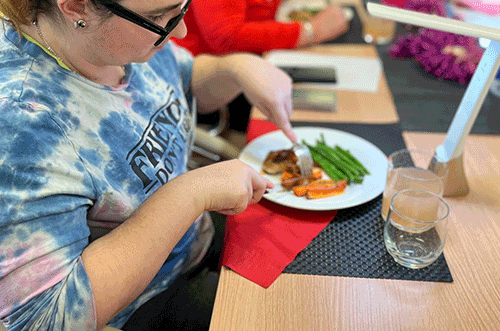Low vision diners can now dine out with confidence

VisAbility WA is helping low-vision diners navigate what is often a complex experience when eating out.
A workshop run by senior occupational therapist Rebecca Comber-Short gives people with low vision the skills to dine out with confidence.
"There are many potential pitfalls and challenges when dining out without sight, which can greatly impact people's confidence and reduce their enjoyment in sharing a meal with others," Comber-Short told the ABC.
"This is something that most sighted people take for granted.
"Some of the common difficulties people might experience are knocking items over on the table, over or under filling glasses, or missing the glass altogether when pouring, experiencing 'empty fork syndrome', dropping food, trouble cutting bite-sized pieces of food, locating items on the plate and table, and reading menus.
"However, there are many tips and tricks, compensatory strategies, modifications, and low vision aids which can assist in overcoming these and other difficulties."
These are difficulties Ella Geralis and Beryl Matthews know too well.
"Navigating stairs and finding restaurants' entrances and exits can be challenging, especially when going upstairs," Geralis, 23, who is legally blind told the ABC.
"I find lighting is also a struggle for me."
Matthews is at the opposite stage of the age spectrum at 93. She said she uses a sighted person to help dine out.
Comber-Short’s course aims to give people in the same situation as Matthews and Geralis the tools to have a better dining experience and says using the dinner plate as a clock can help.
"With the best of intentions, people [trying to help] use the phrase, 'it's over there,' which when you can't see is not very helpful," Comber-Short said.
"But if they said, 'your water bottle is at one o'clock from the position of your plate and it's about 20 centimetres away,' then you've got a much clearer idea of where to locate your water bottle.
"So, it's just about being descriptive and clear."
Further to this, devices such as liquid level indicators beeps after a drink is poured into a glass and reaches a certain level.
Comber-Short wants to see physical and online menus become more accessible this might include using contrast, colour, font size, large print, audio, braille and tactile graphics.
"If the menus on the website could conform to some of the accessibility guidelines, that would be great," she said.
"That's certainly a message that we're really eager to get out there."
Matthews has found the course invaluable. She told the ABC, "The confidence grew from everything we had done, to sitting down at the table and being able to speak to the restaurant steward or stewardess.
"You grew with the course, before that people would be jumping up saying, 'I'll cut your dinner for you,' … but once I did the course, I could cut it, I could do it."
Geralis said she was also more confident.
Jonathan Jackon, 16th April 2024







